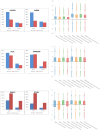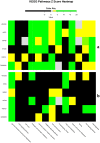A pathway-centric view of spatial proximity in the 3D nucleome across cell lines
- PMID: 27976707
- PMCID: PMC5157015
- DOI: 10.1038/srep39279
A pathway-centric view of spatial proximity in the 3D nucleome across cell lines
Abstract
In various contexts, spatially proximal genes have been shown to be functionally related. However, the extent to which spatial proximity of genes in a pathway contributes to the pathway's context-specific activity is not known. Leveraging Hi-C data in six human cell-lines, we show that spatial proximity of genes in a pathway is highly correlated with the pathway's context-specific expression and function. Furthermore, spatial proximity of pathway genes correlates with interactions of their protein products, and the specific pathway genes that are proximal to one another tend to occupy higher levels in the regulatory hierarchy. In addition to intra-pathway proximity, related pathways are spatially proximal to one another and housekeeping-genes tend to be proximal to several other pathways suggesting their coordinating role. Substantially extending previous works, our study reveals a pathway-centric organization of 3D-nucleome, whereby, functionally related interacting driver genes tend to be in spatial-proximity in a context-specific manner.
Figures








References
Publication types
MeSH terms
Substances
Grants and funding
LinkOut - more resources
Full Text Sources
Other Literature Sources

